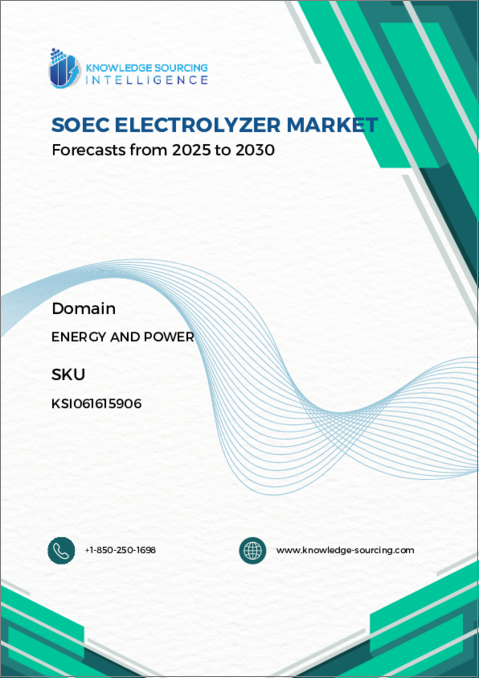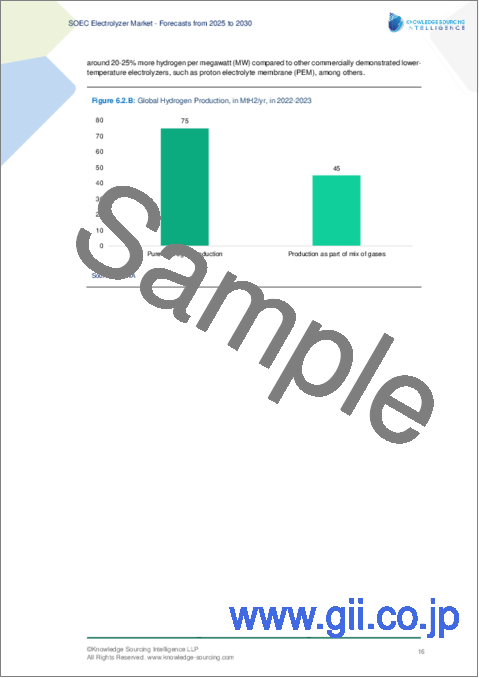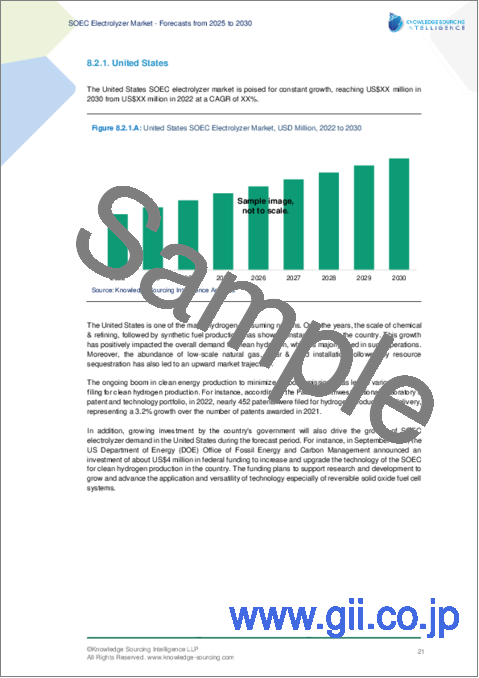|
|
市場調査レポート
商品コード
1627912
SOEC電解槽市場:予測(2025年~2030年)SOEC Electrolyzer Market - Forecasts from 2025 to 2030 |
||||||
カスタマイズ可能
|
|||||||
| SOEC電解槽市場:予測(2025年~2030年) |
|
出版日: 2024年12月16日
発行: Knowledge Sourcing Intelligence
ページ情報: 英文 165 Pages
納期: 即日から翌営業日
|
全表示
- 概要
- 目次
SOEC電解槽市場は、2025年には約5億1,705万5,000米ドルと推定され、2030年にはCAGR 59.71%で53億7,242万米ドルに成長すると予測されています。
固体酸化物電解槽セル(SOEC)は、固体酸化物燃料電池の一種であり、その再生電解能力により、高い電気化学的エネルギー変換装置として使用されます。SOECは、電気分解を達成するために再生モードで作動し、水素と酸素を得るためにセラミック電解質を使用します。エネルギー使用量が少ないため、SOECは水素製造コストの削減にも役立ちます。
SOEC電解槽市場が世界的に成長する主な原動力の一つは、特に自動車産業の代替燃料としての水素需要の増加です。カーボンフットプリントを最小化するためにゼロエミッション車へのシフトが進む中、新エネルギー車への需要が年々高まっており、それによって市場のフットプリントが改善されています。
同様に、商業用、住宅用、工業用の世界のエネルギー需要の増加も水素需要を押し上げ、同時にSOEC電解槽の市場需要を増加させると予想されます。さらに、特にエネルギー産業において、ネットゼロエミッションを達成するための世界のイニシアチブの中で、政府機関や産業界にとって最適な選択は、天然燃料の一形態としての水素にシフトすることです。
SOEC電解槽市場の促進要因
- 自動車燃料の代替としての水素需要の高まり
水素自動車または燃料電池電気自動車(FCEV)は、カーボンフットプリントを削減し、運用コストを低減します。また、クリーンなエネルギー源をベースとしているため、EVの充電時間に比べて燃料補給の時間が短縮されます。電気自動車や内燃機関車よりも高性能であるため、水素自動車や燃料電池電気自動車の需要は伸びており、販売台数も増加しています。
Hydrogen Councilの"Hydrogen Insight 2023 "レポートによると、2023年6月時点の燃料電池自動車の世界累計台数は7万9,000台で、2022年末から10%増加しました。また、同レポートによると、新エネルギー自動車を多く保有する中国、米国、欧州の主要国では、水素自動車普及のために積極的な投資が行われているといいます。
さらに、大手自動車メーカーは、水素燃料電池セグメントの成長機会を最適化することを目指し、FCEVへの投資を進めています。例えば、世界の自動車メーカーであるホンダは、2024年 2月に最新のFCEVであるCR-V eを発表した:FCEVをH2&FC EXPOで発表しました。この水素燃料電池EVは、今年夏から日本で販売される予定です。
本レポートを購入する理由
- 洞察に満ちた分析:顧客セグメント、政府政策と社会経済要因、消費者嗜好、産業別、その他のサブセグメントに焦点を当て、主要地域だけでなく新興地域もカバーする詳細な市場考察を得ることができます。
- 競合情勢:世界の主要企業が採用している戦略的戦略を理解し、適切な戦略による市場浸透の可能性を理解することができます。
- 市場動向と促進要因:ダイナミックな要因と極めて重要な市場動向、そしてそれらが今後の市場展開をどのように形成していくかを探ります。
- 実行可能な提言:ダイナミックな環境の中で新たなビジネスストリームと収益を発掘するための戦略的決断を下すために、洞察を活用します。
- 幅広い利用者に対応:新興企業、研究機関、コンサルタント、中小企業、大企業にとって有益で費用対効果が高いです。
どのような用途で利用されていますか?
業界および市場考察、事業機会評価、製品需要予測、市場参入戦略、地理的拡大、設備投資の決定、規制の枠組みと影響、新製品開拓、競合の影響
調査範囲
- 2022年から2030年までの過去データおよび予測
- 成長機会、課題、サプライチェーンの展望、規制枠組み、顧客行動、およびトレンド分析
- 競合のポジショニング、戦略、および市場シェア分析
- セグメントおよび各国を含む地域の収益成長および予測分析
- 企業プロファイリング(特に主要な開発)
目次
第1章 イントロダクション
- 市場概要
- 市場の定義
- 調査範囲
- 市場セグメンテーション
- 通貨
- 前提条件
- 基準年と予測年のタイムライン
- 利害関係者にとっての主なメリット
第2章 調査手法
- 調査デザイン
- 調査プロセス
第3章 エグゼクティブサマリー
- 主な調査結果
- アナリストビュー
第4章 市場力学
- 市場促進要因
- 市場抑制要因
- ポーターのファイブフォース分析
- 業界バリューチェーン分析
第5章 SOEC電解槽市場:コンポーネント別
- イントロダクション
- BOP
- スタック
第6章 SOEC電解槽市場:用途別
- イントロダクション
- 水素製造
- 工業プロセス
- その他
第7章 SOEC電解槽市場:エンドユーザー別
- イントロダクション
- 電力
- 輸送
- 製油所
- その他
第8章 SOEC電解槽市場:地域別
- イントロダクション
- 南北アメリカ
- 米国
- その他
- 欧州、中東・アフリカ
- ドイツ
- 英国
- その他
- アジア太平洋
- 中国
- 日本
- その他
第9章 競合環境と分析
- 主要企業と戦略分析
- 市場シェア分析
- 合併、買収、合意およびコラボレーション
- 競合ダッシュボード
第10章 企業プロファイル
- Sunfire GmbH
- Fuel Cell Energy Inc.
- Haldor Topsoe
- Elcogen
- Ceres Power Holdings PLC
- Bloom Energy Corporation
- H2Electro
- E&KOA Co.
The SOEC electrolyzer market is estimated to be around US$517.055 million in 2025 and is anticipated to grow to US$5,372.420 million by 2030 at a CAGR of 59.71%.
A solid oxide electrolyzer cell (SOEC) is a type of solid oxide fuel cell, that due to its regenerative electrolysis capabilities is used as a high electrochemical energy conversion device. The SOEC operates in the regenerative mode to achieve the electrolysis and uses ceramic electrolytes to attain hydrogen and oxygens. Due to less energy usage, SOEC is also helpful in reducing the hydrogen production cost.
One of the major driving factors for the SOEC electrolyzer market growth globally is the increase in the demand for hydrogen, especially as a fuel alternative for the automotive industries. With the ongoing shift towards zero-emission vehicles to minimize the carbon footprint, the demand for new energy vehicles has gained traction over the years, thereby improving the market footprint.
Similarly, the increase in the global energy demand, for commercial, residential, or industrial use, is also expected to boost the demand for hydrogen, simultaneously increasing the market demand for SOEC electrolyzers. Additionally, in the global initiative to attain net zero emission, especially in the energy industry, the optimum choice for governmental organizations and industries is to shift towards hydrogen as a form of natural fuel.
SOEC electrolyzer market drivers
- Growing hydrogen demand as an alternative for automotive fuel.
Hydrogen vehicles or Fuel Cell Electric Vehicles (FCEVs) reduce the carbon footprint and offer lower operational costs. Based on a form of clean energy source such vehicles also reduce the time of refill as compared to the charging time of an EV. Owing to their high-performance benefits over electric and ICE-based vehicles the demand for hydrogen or Fuel-cell electric vehicles is witnessing a positive growth, which has elevated their sales volume.
According to the Hydrogen Council's "Hydrogen Insight 2023" report, the global cumulative fuel-cell vehicles as of June 2023 stood at 79,000 units which represented a 10% from the end of 2022. Moreover, the same source further stated that major economies namely China, the United States, and Europe which harbor a large portion of new energy vehicles are experiencing positive investment inflows to further their hydrogen-based vehicle adoption.
Furthermore, major automotive manufacturers are aiming to optimize the growing opportunity in the hydrogen fuel cell segment due to which they are investing in FCEVs. For instance, in February 2024, Honda, a global automotive producer, unveiled its latest FCEV, CR-V e: FCEV at the H2 & FC Expo. The hydrogen fuel cell EV is scheduled to be sold in Japan starting in the summer of the current year.
Reasons for buying this report:-
- Insightful Analysis: Gain detailed market insights covering major as well as emerging geographical regions, focusing on customer segments, government policies and socio-economic factors, consumer preferences, industry verticals, other sub- segments.
- Competitive Landscape: Understand the strategic maneuvers employed by key players globally to understand possible market penetration with the correct strategy.
- Market Drivers & Future Trends: Explore the dynamic factors and pivotal market trends and how they will shape up future market developments.
- Actionable Recommendations: Utilize the insights to exercise strategic decision to uncover new business streams and revenues in a dynamic environment.
- Caters to a Wide Audience: Beneficial and cost-effective for startups, research institutions, consultants, SMEs, and large enterprises.
What do businesses use our reports for?
Industry and Market Insights, Opportunity Assessment, Product Demand Forecasting, Market Entry Strategy, Geographical Expansion, Capital Investment Decisions, Regulatory Framework & Implications, New Product Development, Competitive Intelligence
Report Coverage:
- Historical data & forecasts from 2022 to 2030
- Growth Opportunities, Challenges, Supply Chain Outlook, Regulatory Framework, Customer Behaviour, and Trend Analysis
- Competitive Positioning, Strategies, and Market Share Analysis
- Revenue Growth and Forecast Assessment of segments and regions including countries
- Company Profiling (Strategies, Products, Financial Information, and Key Developments among others)
The SOEC electrolyzer market is segmented and analyzed as follows:
By Component
- BOP
- Stack
By Application
- Hydrogen Production
- Industrial Process
- Others
By End-User
- Power
- Transportation
- Refineries
- Others
By Geography
- Americas
- United States
- Others
- Europe, Middle East and Africa
- Germany
- United Kingdom
- Others
- Asia Pacific
- China
- Japan
- Others
TABLE OF CONTENTS
1. INTRODUCTION
- 1.1. Market Overview
- 1.2. Market Definition
- 1.3. Scope of the Study
- 1.4. Market Segmentation
- 1.5. Currency
- 1.6. Assumptions
- 1.7. Base and Forecast Years Timeline
- 1.8. Key Benefits for the Stakeholders
2. RESEARCH METHODOLOGY
- 2.1. Research Design
- 2.2. Research Process
3. EXECUTIVE SUMMARY
- 3.1. Key Findings
- 3.2. Analyst View
4. MARKET DYNAMICS
- 4.1. Market Drivers
- 4.2. Market Restraints
- 4.3. Porter's Five Forces Analysis
- 4.3.1. Bargaining Power of Supplier
- 4.3.2. Bargaining Power of Buyers
- 4.3.3. Threat of New Entrants
- 4.3.4. Threat of Substitutes
- 4.3.5. Competitive Rivalry in the Industry
- 4.4. Industry Value Chain Analysis
5. SOEC ELECTROLYZER MARKET BY COMPONENT
- 5.1. Introduction
- 5.2. BOP
- 5.3. Stack
6. SOEC ELECTROLYZER MARKET BY APPLICATION
- 6.1. Introduction
- 6.2. Hydrogen Production
- 6.3. Industrial Process
- 6.4. Others
7. SOEC ELECTROLYZER MARKET BY END-USER
- 7.1. Introduction
- 7.2. Power
- 7.3. Transportation
- 7.4. Refineries
- 7.5. Others
8. SOEC ELECTROLYZER MARKET BY GEOGRAPHY
- 8.1. Introduction
- 8.2. Americas
- 8.2.1. United States
- 8.2.2. Others
- 8.3. Europe, Middle East And Africa
- 8.3.1. Germany
- 8.3.2. United Kingdom
- 8.3.3. Others
- 8.4. Asia Pacific
- 8.4.1. China
- 8.4.2. Japan
- 8.4.3. Others
9. COMPETITIVE ENVIRONMENT AND ANALYSIS
- 9.1. Major Players and Strategy Analysis
- 9.2. Market Share Analysis
- 9.3. Mergers, Acquisitions, Agreements, and Collaborations
- 9.4. Competitive Dashboard
10. COMPANY PROFILES
- 10.1. Sunfire GmbH
- 10.2. Fuel Cell Energy Inc.
- 10.3. Haldor Topsoe
- 10.4. Elcogen
- 10.5. Ceres Power Holdings PLC
- 10.6. Bloom Energy Corporation
- 10.7. H2Electro
- 10.8. E&KOA Co.





